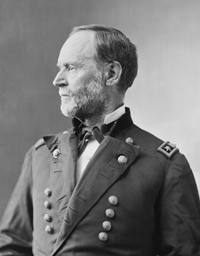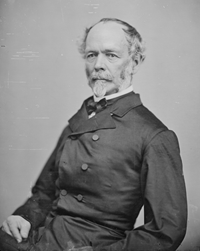

Bentonville Battlefield
Date of Battle: March10-14, 1865
Location: Museum of the Cape Fear Historical Complex, Downtown Fayetteville (currently only a memorial park on other side of MLK parkway from Museum)
Information: Currently there is only a road marker of this battle, the original farmhouse has burned down and location of any graves are in artillery impact area on Fort Bragg. They can be seen on appointment.

Union Army
MG Hugh J. Kilpatrick
Kilpatrick's Cavalry Division
Strength: 1,850

Confederate Army
LT Gen Wade Hampton and LT Gen Joseph Wheeler
Wheeler’s Cavalry Division and Hampton’s Cavalry Division
Strength: 3,000
Battle of Bentonville
As Sherman gained a lodgment in South Carolina, Fort Fisher fell to a Federal amphibious assault on January 15, 1865. This effectively closed the port of Wilmington, North Carolina—the hub of the last major supply route to Lee's army in Virginia. Wilmington itself would fall in February to the combined forces of Gen. Alfred H. Terry's Provisional Corps and Gen. John Schofield's XXIII Corps, hammering yet another nail into the coffin of the Confederacy. Grant's orders to Schofield specified that "Your movements are intended as co-operative with Sherman through the States of South and North Carolina. The first point to be attained is to secure Wilmington. Goldsborough will then be your objective point." Grant realized the importance of Goldsboro as the inland junction of the Wilmington & Weldon and Atlantic & North Carolina railroads. At least 425 miles of enemy territory lay between "Uncle Billy" and his ultimate destination in North Carolina, and a rendezvous there with Schofield and Terry.
Sherman's army advanced on February 1, 1865, meeting little resistance as it marched northward. General P. G. T. Beauregard did in fact divide his Confederate forces to safeguard Charleston to the east, and Augusta, Georgia to the west.
This unfortunate arrangement allowed Sherman's Army to pass through the heart of South Carolina virtually unopposed, cutting a wide swath of destruction as they advanced. With the city of Columbia and much of the South Carolina countryside in ruins, only North Carolina lay between Sherman's army and a junction with U. S. Grant's army in Virginia. To make matters worse for the Southern war effort, the Army of Tennessee and other Confederate forces in the Carolinas were widely scattered. With Robert E. Lee's army bogged down against Grant in the trenches of Petersburg, and Sherman's force swiftly approaching from the south; it was a dire time for the Confederacy.
Significance
As general-in-chief of all Southern armies, Lee questioned General Beauregard's ability to oppose the Federals. As the Union juggernaut continued northward, Lee appealed to the Confederate War Department for a replacement, explaining that he knew of no officer who had so much "the confidence of the army and people" as Gen. Joseph E. Johnston. Lee's choice for the command was not a popular one with Confederate president Jefferson Davis, who deemed Joe Johnston a personal enemy.
In one of the great personality clashes of the Civil War, the troubled relationship between Davis and Johnston came to a head in mid-July 1864, during the Atlanta Campaign. Furious with Johnston for retreating before Sherman in Georgia instead of engaging him in a decisive battle, Davis promptly removed "Old Joe" from command of the Army of Tennessee. But the Confederate president counted few options as Sherman approached North Carolina, and with Lee's earnest request Davis gave in and reluctantly allowed the general-in-chief to call upon Johnston for his services.
On February 22, 1865, Lee sent an urgent dispatch to his old friend Johnston, who had retired to Lincolnton, North Carolina: "Assume command of the Army of Tennessee and all troops in Department of South Carolina, Georgia, and Florida. Assign General Beauregard to duty under you, as you may select. Concentrate all available forces and drive back Sherman."
Though he felt the effort to stop Sherman had come too late, a weary Johnston methodically set out to collect the scattered array of Confederate forces at his disposal. The troop concentration he would effect in North Carolina on short notice, and the resulting battle at Bentonville, would stand in sharp contrast to the general's earlier war record.
The Final Major Battle of the Civil War in North Carolina
Day One: While Slocum’s left wing advance was stalled at Averasboro on March 15-16 by Hardee’s troops; the right wing of Sherman’s army under command of Maj. Gen. O.O. Howard marched toward Goldsboro. On March 19, Slocum encountered the entrenched Confederates of Gen. Joseph E. Johnston who had concentrated his army to meet his advance at Bentonville. Joseph E. Johnston organized his forces into a hook-shaped line at Cole's Plantation, blocking the Goldsboro Road. That morning William T. Sherman's Federal Left Wing stumbled into the Confederate trap, just as it was being set. After a Union probing attack failed, the Confederates launched a massive assault which drove Gen. William P. Carlin's XIV Corps division from the field. Morgan's division managed to hold on despite being surrounded on three sides by Confederate adversaries. Late that afternoon a strong Federal defense of the Morris Farm by the Left Wing's XX Corps were thrown into the action as they arrived on the field. Five Confederate attacks failed to dislodge the Federal defenders and darkness ended the first day’s fighting. Elements of the XX Corps managed strong counterattacks and desperate fighting south of the Goldsboro Road blunted the Confederate offensive.
Day Two: Failing to completely crush the Union lines, Johnston's Confederates pulled back to positions held earlier in the day. During the night, Johnston contracted his line into a “V” to protect his flanks with Mill Creek to his rear. On March 20, Sherman's Right Wing began arriving on the battlefield by midday on March 20, Slocum was heavily reinforced, but fighting was sporadic. Sharp skirmishing prevailed, as the Confederates changed position to deal with the arrival of the Federal Right Wing. The junction of Sherman's divided army at Bentonville placed nearly 60,000 Union troops (including reserves) against Joe Johnston, who had brought to the field approximately 16,000 infantry and 4,000 cavalry with which to oppose Sherman. Despite receiving limited reinforcements, the Confederates were no match numerically for the powerful Union army.
Johnston clung to a tenuous position guarding his army's sole escape route over rain-swollen Mill Creek, and began evacuating his wounded to Smithfield, 20 miles to the north.
To Sherman's great irritation, he found the Confederate army still in position on March 21. The Union commander was anxious to reach Goldsboro, and was impatient for the Confederates to retreat. Johnston, outnumbered and no longer holding the advantage of surprise, could only hope that the Federals might be lured into a costly frontal attack on his small but well-entrenched army.
Day Three: however, Johnston remained in position while he removed his wounded. Skirmishing heated up along the entire front. In the afternoon, Maj. Gen. Joseph Mower led his Union division along a narrow trace that carried it across Mill Creek into Johnston’s rear. Mower's XVII Corps division then escalated into a full-scale push toward Mill Creek Bridge on the Confederate left flank. Mower's charge overran Joe Johnston's headquarters, forcing the general and his entourage to beat a hasty retreat. At this critical juncture a well-orchestrated Confederate counterattack, led by Lt. Gen. William J. Hardee, quickly descended upon Mower's two brigades and forced them back. Confederate counterattacks stopped Mower’s advance, saving the army’s only line of communication and retreat. Sherman called a halt to the operation, but not before Mower's men were roughly handled by a combination of Confederate cavalry and infantry. Hardee's bold action assured Johnston the use of Mill Creek Bridge, his only means of egress from the battlefield. But the triumph of forcing the Federals back came at a personal cost to General Hardee. His only son, a youth of sixteen in the 8th Texas Cavalry, was mortally wounded in the charge against Mower. With no further advantage to be gained by holding a position at Bentonville, Johnston's weary troops abandoned their works during the night and withdrew toward Smithfield.Around 10pm, Johnston retreated across the Mill Creek bridge at Bentonville.
Retreat – Confederates head towards Raleigh:
On March 22 Federal forces pursued the retreating Confederates as far as Hannah's Creek before giving up the chase. Sherman was content to let Johnston escape, fully expecting to have to deal with him again at a later date. But the Confederate withdrawal cleared the way for Sherman to occupy Goldsboro, which was foremost in the general's mind. His army needed rest and provisions, and Sherman also wanted to have the additional forces of J. M. Schofield and A. H. Terry before tangling with Johnston again.
The armies of Sherman, Schofield, and Terry converged on Goldsboro and occupied the town for two and one-half weeks in preparation for the final leg of the campaign.